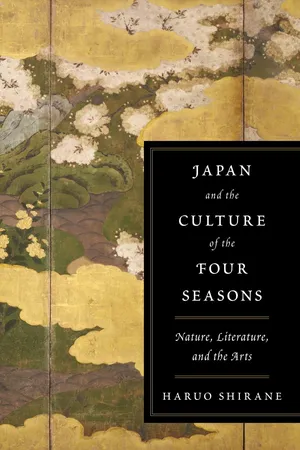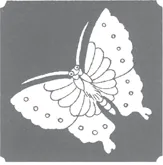![]()
Chapter One
Poetic Topics and the Making of the Four Seasons
One of the major reasons for the prominence of nature and the four seasons in Japanese literary and visual culture is the impact of Japanese poetry, particularly the thirty-one-syllable waka (classical poetry), the main literary genre of the premodern period. Indeed, all the major types of Japanese poetry—kanshi (Chinese-style poetry), waka, renga (classical linked verse), and haikai (popular linked verse)—use natural themes extensively.
Nature as Metaphor
In an East Asian tradition going back to the Six Dynasties period (220–589) in China, poetry was generally expected to do one of three things: express emotions or thoughts (jō) directly, describe a “scene” (kei) directly, or express emotion or thought through a scene. Since it was generally preferable in the Heian period (794–1185) to express emotions and thoughts indirectly, elegantly, and politely, the third option became the primary mode of social exchange. Love poetry is often associated with the first technique, and nature poetry with the second, but the third became the preferred mode for both nature and love poetry. Even those poems that appear on the surface to describe only landscape or nature serve to express particular emotions or thoughts. Japanese poetry rarely uses overt metaphor (for example, “My love is a rose”). Instead, the description of a flower, a plant, an animal, or a landscape became an implicit description of a human or an internal state. Metonymy, especially the construction of a larger scene from a small detail, also played a crucial role, particularly in short forms like waka and seventeen-syllable hokku (opening verse of renga sequence). From the perspective of the reader, all such poetry will potentially have a surface (literal) meaning and a deeper meaning. Representations of nature in aristocratic visual culture—whether painting, poetry, or design—are thus seldom simply decorative or mimetic; they are almost always culturally and symbolically encoded, and that encoding tends to evolve with time and genre.
The “harmony” between the natural and human spheres that exists in waka and waka-related genres and media derives in part from a prominent rhetorical feature that we might call doubleness, in which the text operates at two levels simultaneously. One of the major features of waka is the frequent use of puns (kakekotoba) and engo (words culturally or phonetically linked), which allows two levels (usually human and natural) to coexist in a compact form. Mount Fuji, for example, which appeared in poetry from as early as the eighth century, was associated with omohi (melancholy thoughts), which had a homophone suffix hi (fire) that implied both volcanic fire and smoldering passion. Thus to compose a poem in the Heian period on the smoke of Mount Fuji, which was a live volcano at that time, was implicitly to compose on the topic of love. The two primary topics in waka were the seasons and love, with love being implicit in the seasonal poems and the seasons and nature being the primary expressions of love.
Two major Chinese poetry anthologies, dating to the Six Dynasties period, that had a huge impact on Heian and subsequent Japanese poetry were the yutai xinyong (Jp. Gyokudai shin’ei; New Songs of the Jade Terrace), compiled by Xu Ling (507–583), and the Wen xuan (Jp. Monzen; Selections of Refined Literature), compiled in the Liang era (502–557). The seasons, particularly autumn and spring, are important in Six Dynasties poetry, and many of these seasonal associations would emerge in Japanese poetry. Chinese poetry anthologies were organized by author, genre, and style, a pattern that Japanese poetry anthologies initially followed, but a significant difference emerged in that Japanese waka anthologies, beginning with books 8 and 10 of the Man’yōshū and culminating in the Kokinshū and subsequent imperial waka anthologies, also carefully arranged the poems on an elaborate temporal and seasonal grid so that attention was paid to all phases of the seasons. The prominence of seasonal poetry is evident in the Kokinshū, whose first five books are devoted to the seasons.
In the course of the Heian period, a broad range of natural objects acquired specific seasonal associations. The result was that much of Japanese nature poetry became seasonal poetry. For example, deer (shika) live in Japan all year round, but in classical Japanese poetry the image of the deer became associated with autumn and with the mournful, lonely cries of the stag looking for his mate. The deer thus became the embodiment of a particular emotional state as well as a seasonal marker of autumn and was coupled with other autumnal topics, such as bush clover (hagi) and dew, to form part of a larger grammar of seasonal poetry. Each seasonal topic generated a cluster of associations, and the seasons themselves (along with famous poetic places) developed associative clusters that became part of a cultural vocabulary.
The Man’yōshū and the Emergence of Seasonal Poetry
The seasonal associations were first developed by waka poets in the Nara period (710–784) and then refined and systematized by waka poets in the Heian and Kamakura (1185–1333) periods, before being inherited by renga (classical linked verse) poets in the Muromachi period (1392–1573) and then radically expanded by haikai (popular linked verse) poets in the Edo period (1600–1867). There is little seasonal poetry until the mid-seventh century, in the ancient songs of the two early chronicles, the Kojiki (Record of Ancient Matters, 712) and Nihon shoki (Chronicles of Japan, 720), or in the earliest songs and poetry of the Man’yōshu (Collection of Ten Thousand Leaves, ca. 759). Seasonal poetry began to emerge only in the late seventh century and finally came to the fore in the eighth century, particularly after the move to the new capital at Heijō (Nara) in 710. The seasonal poems collected in books 8 and 10 of the Manyōshu, which date mainly from the first half of the eighth century, were organized by season and by topic. These seasonal topics, which remained remarkably consistent over the next thousand years, gradually increased and evolved over time.
A wide variety of plants are identified in early texts up through the reign of Emperor Tenji (626–671; r. 668–671). They serve a broad range of practical purposes—from food; through medicine, building materials, and dyes; to clothing. But in poetry, the focus is on evergreens and flowering trees, both of which were believed to have special magical powers. The only seasons to draw attention are spring and autumn, notably in the famous chōka (long poem [Man’yōhū 1:16]) by Princess Nukata (fl. late seventh century), in which she debates the relative merits of spring and autumn. The early prominence of spring and autumn can probably be traced to two causes: the prominence of these two seasons in Chinese poetry, and the agricultural roots of seventh-century society. Spring was the time for planting, while autumn was the season for harvesting the five grains (gokoku). Various annual observances were carried out in the spring (such as land viewing [kuni-mi], gathering new herbs, and fence poem fests [utagaki]) to pray for prosperity, a rich harvest, long life, and fertility;1 in the autumn, another set of annual observances was performed to offer thanks for the harvest.
In the mid-seventh century and even earlier, spring was the more prominent season than autumn, probably because of its connection to various rituals related to the New Year and prayers for fertility. However, Princess Nukata’s long poem, which favors autumn, suggests that by the reign of Emperor Tenji, autumn had come to overshadow spring. The impact of Chinese poetry, which is partial to autumn, probably played a major role in this shift of interest. Significantly, Nukata focuses only on bright yellow leaves (momichi) as the representative image of autumn and does not mention bush clover ([agi), the autumn moon, wild geese, or autumn mist (kiri), all of which became major autumn topics in the late seventh and eighth centuries.
The number of seasonal poems grew in the so-called second Man’yōshu period (672–710), including one on the movement of the seasons attributed to Empress Jitō (645–702; r. 690–697): “It seems that spring has gone and summer has arrived: hanging out to dry, the white hemp robes at Heavenly Kagu Mountain” (Haru sugite natsu kitaru rashi shirotae no koromo hoshitari Ame no Kaguyama [1:28]). Another characteristic of poetry of this period is the combination of seasonal motifs: “Small cuckoo, do not sing so much! Not until I can pass your voice through the jewels of the Fifth Month” (Ho-totogisu itaku na naki so na ga koe wo satsuki no tama ni aenuku made ni [8:1465]).2 The poet tells the small cuckoo (later to be a major summer topic) that it should not cry until its voice can pass through the fruit (jewel) of the mandarin orange (tachibana), which became the primary poetic plant of summer. These seasonal poems also show empathy toward animals and plants, as in this poem attributed to Emperor Okamoto, whom scholars believe to be Emperor Jomei (593–641; r. 629–641): “The deer at Ogura Mountain, which cries when evening arrives, appears to have fallen asleep tonight without crying” (Yū sareba Ogura no yama ni naku shika wa koyoi wa nakazu inenikerashi mo [8:1511]). The deer, presented as a lonely stag seeking his mate, becomes an implicit metaphor for the poet’s internal state. Speculation on the movement of the seasons, the use of different seasonal motifs, and empathy for or identification with a plant or an animal—all became enduring features of Japanese nature poetry.
Seasonal poetry did not come into its own until the early eighth century, particularly in the Tenpyō era (729–749) and the so-called third Man’yōshu period (710–733), when Chinese poetry flourished in Japan, bringing with it a strong awareness of the seasons, particularly spring and autumn. Most of these poems are found in books 8 and 10 of the Man’yōshū, which are divided into miscellaneous poems (zōa) and love poems (sōmon). The love poems use images of nature and the seasons to express longing and love, as in this spring poem: “[(A poem sent by Ōtomo no Yakamochi to the daughter of the Sakanoue family) How I wish the seeds of the pink that I planted...

